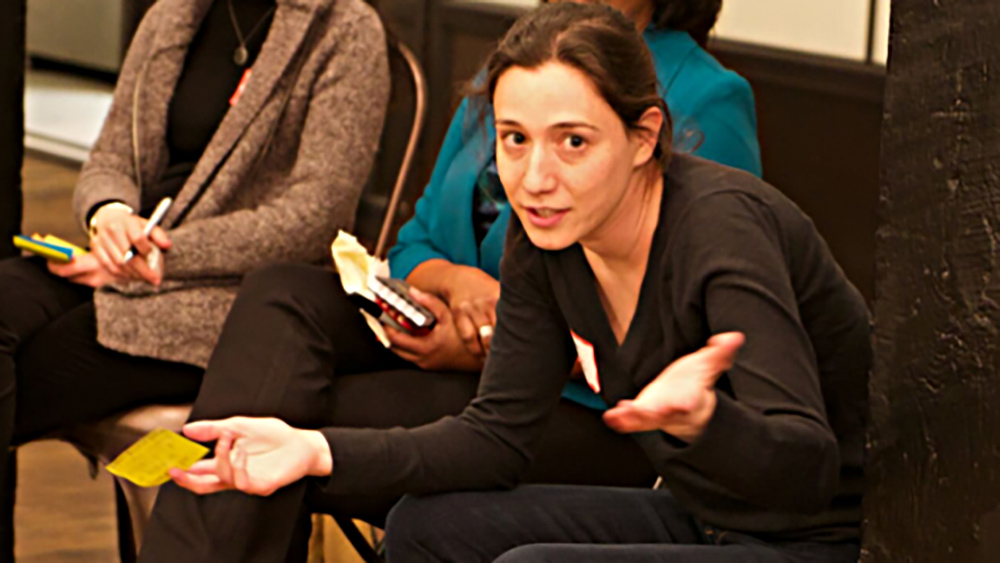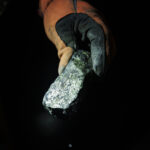@ScienceMarchDC: The Organizers
Caroline Weinberg doesn’t like the word “founder.” “If I’d had work that morning,” she says of the day the March for Science went viral, “you’d be talking with someone else right now.”
It was late January when Weinberg, a public health physician who works as a science writer and an independent advocate for reproductive health in adolescents, was lying in bed in her apartment in New York, “just idly being horrified,” she says, about the dismal state of science in America. Donald Trump had just been inaugurated, and the impact was already being felt. A friend who worked for the feds in climate education had been told not to communicate with the public, and Weinberg says she was disgusted.

Caroline Weinberg is a reluctant revolutionary. “If I’d had work that morning,” she says of the day the March for Science went viral, “you’d be talking with someone else right now.”
Visual: Ginny Suss
At 33, her entire professional life had happened alongside what she characterizes as the slippage of science out of the public sphere and the rise of anti-empirical ideas like resurgent creationism, the demonizing of vaccines, and climate change denial. She’d watched as opportunities for young scientists closed in a profession ever more dependent on adjunct labor.
It wasn’t hard to see where things were headed: Under Trump, the government was pulling back even further from science, meaning those doors would continue to close.
Weinberg wanted to do something. On January 21, one day after Trump’s inauguration, millions of people had shown up for Women’s Marches in cities around the world, in a spontaneous and organic display of mass power and dissatisfaction that had overwhelmed even its own organizers. She marveled at the sprawling nature of the Women’s March success, but thought, a science march would be easier thanks to the highly-institutionalized nature of science: “Seems like it would be pretty easy,” she wrote to a friend. “Just reach out to academics at local universities and they’ll organize themselves. Let’s do that. I’d fucking throw down for a science march.”
Now in mid-April, less than two weeks before that march becomes a reality, Weinberg sits in a church square in New York’s Lower East Side and laughs at her own naïveté. “I really thought it would be that easy,” she says. She’d also thought they would have plenty of time to get organized. Weinberg, like many scientists, is a planner: cautious, worried about being misunderstood or misconstrued. In her idea of organizing — she’d started a tutoring program in college, and a sex education program in medical school — you got a solid plan and went live only after you’d worked out the kinks. So when she signed on to Twitter back in January, she imagined that a few dedicated people like her would get together, build a program, reach out to experts, and launch the march once everything was ready.
But it didn’t happen that way. Like the Women’s March, or Standing Rock, or any number of other spontaneous protest movements of the last year, the event almost immediately hit swells that threatened to capsize it entirely. Weinberg typed “science march” into Twitter’s search box and found that a few people were already beginning to post about it. Weinberg — who had tweeted perhaps two dozen times in nearly a decade — wrote to them, and they put her in touch with Jonathan Berman, a molecular biologist in Washington D.C. who had reserved the Twitter handle @ScienceMarchDC. Weinberg and Berman posted about a science march, and watched as it took off before their eyes.
A promotional video for the March For Science, produced by one of the event’s partners.
Within hours, the @ScienceMarchDC account had gone from fewer than 100 followers to more than 30,000. (It has over 345,000 today.) Weinberg and Berman’s inboxes flooded with emails from people asking how they could help. “We were just trying to keep our heads above water,” Weinberg says. To help manage the torrent of emails, she created a Google form for prospective volunteers to fill out. Within 24 hours, more than 22,000 people had filled it out. After five days, the number had passed 45,000. Scientists and organizers all over the world were writing in, asking for help in setting up their own marches.
Other help came in. The organizers still hadn’t picked an official date for the march when, 24 hours after they went viral, the advocacy group Earth Day Network reached out. It had already secured permits for a demonstration and teach-in on the National Mall on Earth Day — Saturday, April 22. If the March for Science would partner with the group, it could cut through a great amount of bureaucratic wrangling. “We discussed it internally,” Weinberg says. “and we decided to accept this gift we’d been given.”
Since then, the signature march in Washington has evolved to include hundreds of satellite marches in hundreds of cities worldwide, and an alphabet soup of science societies comprising the bulk of institutional American science have joined the effort, as have numerous museums and teachers’ unions. Organizations like the American Geophysical Union, the Genetics Society of America, and the American Society for Cell Biology — groups that don’t normally talk to one another — have all signed on, and the March for Science website now lists more than 180 partners.
“It was completely spontaneous,” says Rush Holt, a former Democratic Congressman from New Jersey who is now director of the American Association for the Advancement of Science, perhaps the flagship institution of American science. “This is the first time in decades there has been a public outcry not just for a particular research or technology but an outcry about the need to defend science and scientific policies.” When he was asked who was responsible for getting the march off the ground, Weinberg was first on his list.
That’s hardly what she had in mind that first morning, as she stared at the emails pouring in. “It’s impossible for me to imagine more than 50 people coming to anything that I plan,” she says. “There’s this feeling you get when you’re talking to a cloistered group, and your friends are upset, but maybe you’re alone. So the fact it took off so quickly was comforting. But also,” she adds, pausing, “terrifying.”
Within eight hours, the march had gone from an idle dream to something that was happening, and now she was one of the people in charge.
“Immediately,” she recalls, “we realized we needed help.” They needed graphic designers and web developers to make a website; skilled writers to do communications and draft a mission statement they could take to science societies; people with experience working in diversity in STEM to ensure it was a key element of the foundation of the organization; social media managers to manage the organization’s role in a spreading online movement; and organizers to keep in touch with the satellite marches around the world. “Already one-and-a-half days afterwards, there were people writing negative things in the media about how the march stood for the wrong things — and we’re like, we haven’t told you yet what we stand for!” Weinberg says.

Aside from the Women’s March, there was little precedent for this sort of confederated grass-roots demonstration. There have been other mass marches, of course — the civil rights March on Washington of 1963, the 2003 peace marches around the Iraq War, to name two — but the speed and spontaneity of these recent demonstrations are a phenomenon of the social media age, and the first few dozen people to fill in Google Forms became the nucleus of the planning committees for the science march. There was no time to look at résumés. One early volunteer, after being asked to please stop making flippant comments about sexual assault, threatened to publish private or identifying information about other volunteers, and tried to have a team member deported. (“In hindsight, bringing on strangers from the internet without vetting them may not have been the best strategy,” Weinberg admits.)

In just a few short months, the Twitter profile for @MarchForScienceDC has exploded.
But several days of frantic writing later, they had a credo: “The March for Science champions robustly funded and publicly communicated science as a pillar of human freedom and prosperity.” They described themselves as nonpartisan, despite Trump’s role in provoking the movement, and they were marching for the integrity of scientists and the integrity and independence of the scientific process. They were also marching to reintroduce America to the hidden role of science and scientists in their lives, and to advocate for science and “evidence-based policies” to hold greater sway in politics. And they were marching to advance diversity within science — not only in ethnic and gender terms, but also in terms of the many fields of science.
The goal, then, as with other grassroots movements, is not only to defend science but to transform it from within. To Weinberg’s mind, institutional science stumbled in the 20th century by retreating from public life. Disciplines had become siloed, scientific treasures had been locked behind pay-walled journals, and science itself had refused for too long to address glaring problems with diversity and labor relations. “Our missteps in the beginning opened up a festering wound in the body of science,” Weinberg says. “A dialog opened that revealed major issues that have been institutionally brushed under the rug for a long time. It’s forcing scientists and science supporters to face issues with how things are structured in science, particularly with regard to diversity.
“Part of how science is set up is how we got here” she says. “If we want science to influence policy, it needs to be the best it can be.”
Despite some early setbacks, nearly all of the original volunteers are still with the march more than two months later, through hours of unpaid work. “You know that people are fully committed because no one’s getting paid,” laughed Ayana Johnson, a marine biologist and private consultant focusing on ocean conservation, who serves as co-director of partnerships and is a member of the diversity committee for the march. All told, the event has come together on a shoestring budget — roughly $3000, Weinberg says, for the website, email, and other costs — and all of it raised from small donations.
When I met some of the core organizers in New York, they were spread out working at a bar table. “It’s strange to think that my most meaningful relationships these days are on Slack,” Weinberg tells the group. “It’ll be strange when I’m not talking to you guys all the time.”
If she has her way, they won’t stop. To Weinberg and her team, the march is only the first step in the stitching together of a new movement around science activism, the first wave in an internal revolution aimed at a new model of science and politics. “We have no intention of stopping after the march,” Weinberg says. “The goal is a lasting organization on a national level, advocating for science in policy, and bringing our partners along. If this doesn’t last post-April 22, it’ll be a massive failure.”
Saul Elbein is a freelance journalist from Austin, Texas. His work has appeared in the New York Times Magazine, Texas Observer, and on This American Life.
Correction: An earlier version of this story referred imprecisely to the role played by Ayana Johnson within the March for Science organization. She is co-director of partnerships, and a member of the diversity committee for the event, but she is not in charge of diversity matters, as the original wording implied.










